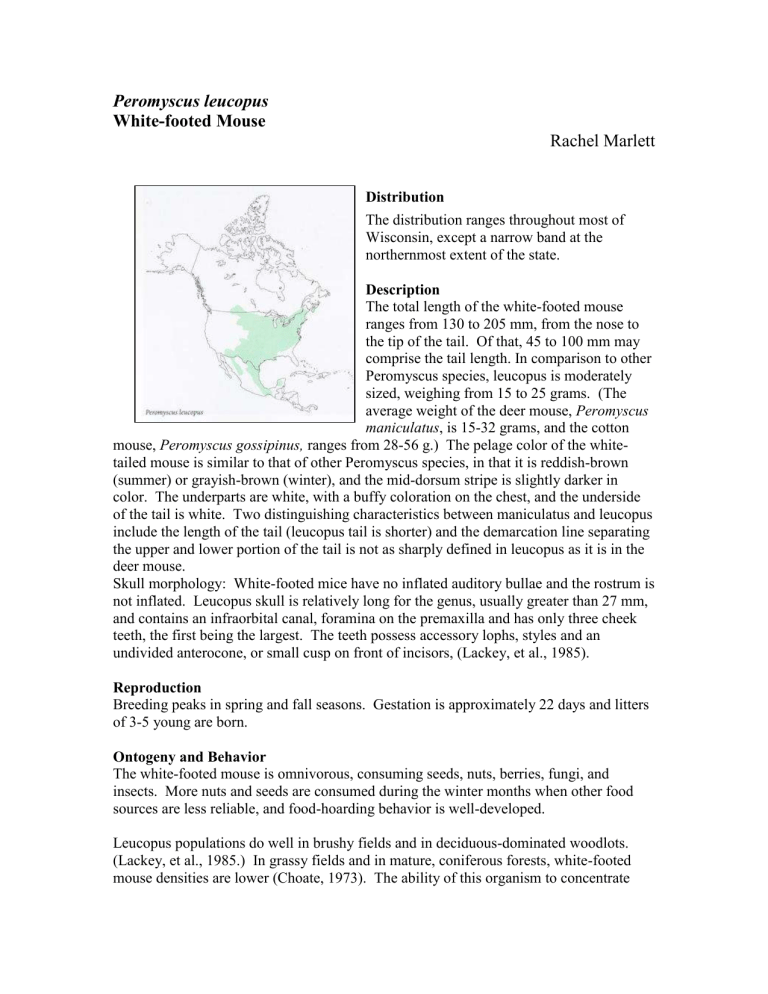Peromyscus leucopus White-footed Mouse Rachel Marlett

Peromyscus leucopus
White-footed Mouse
Rachel Marlett
Distribution
The distribution ranges throughout most of
Wisconsin, except a narrow band at the northernmost extent of the state.
Description
The total length of the white-footed mouse ranges from 130 to 205 mm, from the nose to the tip of the tail. Of that, 45 to 100 mm may comprise the tail length. In comparison to other
Peromyscus species, leucopus is moderately sized, weighing from 15 to 25 grams. (The average weight of the deer mouse, Peromyscus maniculatus , is 15-32 grams, and the cotton mouse, Peromyscus gossipinus, ranges from 28-56 g.) The pelage color of the whitetailed mouse is similar to that of other Peromyscus species, in that it is reddish-brown
(summer) or grayish-brown (winter), and the mid-dorsum stripe is slightly darker in color. The underparts are white, with a buffy coloration on the chest, and the underside of the tail is white. Two distinguishing characteristics between maniculatus and leucopus include the length of the tail (leucopus tail is shorter) and the demarcation line separating the upper and lower portion of the tail is not as sharply defined in leucopus as it is in the deer mouse.
Skull morphology: White-footed mice have no inflated auditory bullae and the rostrum is not inflated. Leucopus skull is relatively long for the genus, usually greater than 27 mm, and contains an infraorbital canal, foramina on the premaxilla and has only three cheek teeth, the first being the largest. The teeth possess accessory lophs, styles and an undivided anterocone, or small cusp on front of incisors, (Lackey, et al., 1985).
Reproduction
Breeding peaks in spring and fall seasons. Gestation is approximately 22 days and litters of 3-5 young are born.
Ontogeny and Behavior
The white-footed mouse is omnivorous, consuming seeds, nuts, berries, fungi, and insects. More nuts and seeds are consumed during the winter months when other food sources are less reliable, and food-hoarding behavior is well-developed.
Leucopus populations do well in brushy fields and in deciduous-dominated woodlots.
(Lackey, et al., 1985.) In grassy fields and in mature, coniferous forests, white-footed mouse densities are lower (Choate, 1973). The ability of this organism to concentrate
urine efficiently also allows it to survive in relatively xeric environments, under conditions in which water or food scarcity is a factor. Another adaptation this species has to prevent water loss is daily torpor, which is triggered genetically on a regular basis, but also induced by food deprivation.
White-footed mice have adaptations that allow them the ability to climb trees and be classified as semi-arboreal. One of those characters is the tail, used to prop the animal and create balance as they climb. This species general nests near the ground, sometimes in rock piles, logs, stumps and in ground burrows. They construct their nest of materials such as grass, hair, feathers, leaves, bark and moss.
Remarks
Peromyscus leucopus is a reservoir for hantaviruses such as the “Four-Corners virus,” which has great implications to human health. This virus is an etiological agent for a serious respiratory illness called Hantavirus Pulmonary Syndrome, or HPS. (Hjelle, B. et al., 1995). The virus is transmitted to humans through inhalation of contaminated rodent feces.
Works Cited
Choate, J.R. 1973. Identification and recent distribution of white-footed mice
( Peromyscus ) in New England. Journal of Mammology.
Vol:54:41-19
Hjelle B., et al. 1995. Molecular linkage of hantavirus pulmonary syndrome to the white-footed mouse, Peromyscus leucopus : genetic characterization of the M-genome of
New York virus. Journal of Virology . 1995. Vol:69(12):8137-41.
Kurta, A. 1995. Mammals of the Great Lakes Region. Revised Edition. University of
Michigan Press, USA.
Whitaker, J.O. Jr. 1996. National Audubon Society Field Guide to Mammals. Revised
Edition. Alfred Knopf, Publisher. New York, USA. p. 590.
Reference written by Rachel Marlett, Biol 378: Edited by Chris Yahnke. Page last updated.



